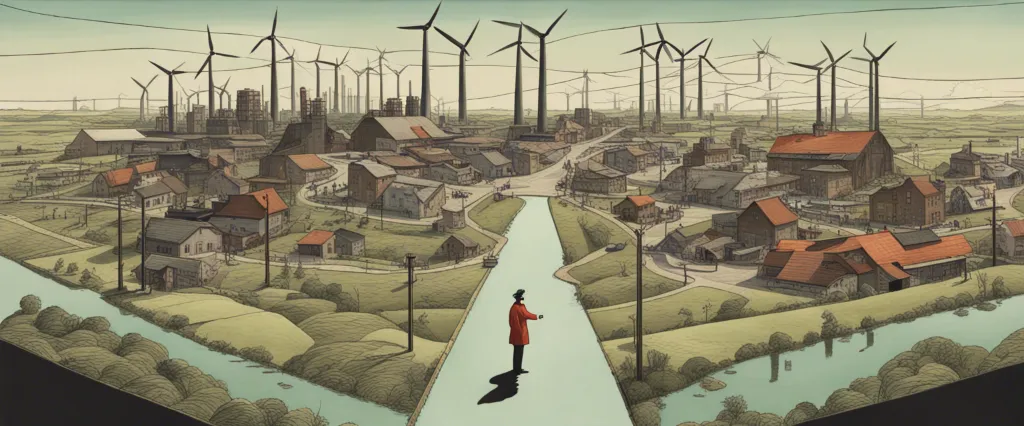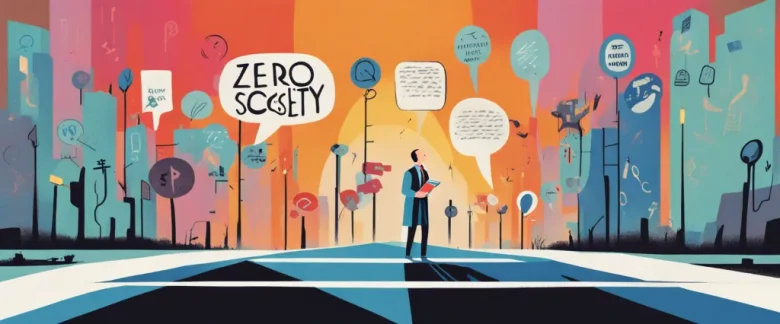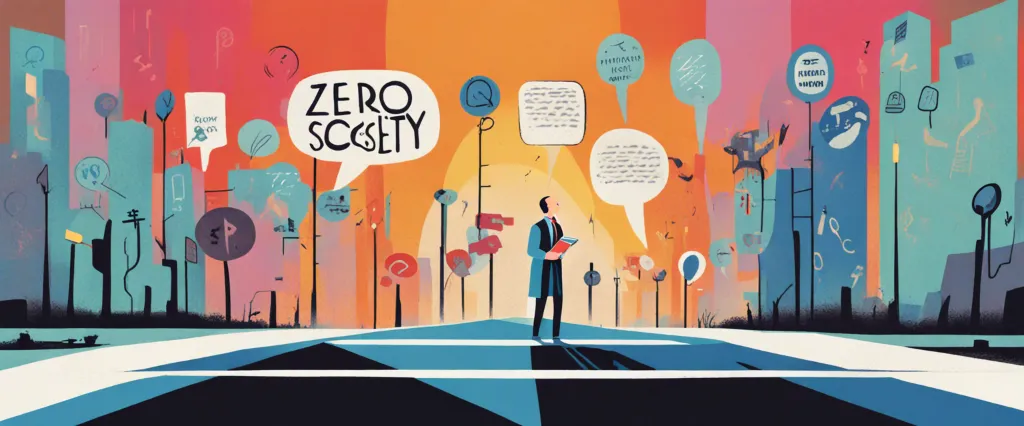In “The Zero Marginal Cost Society,” acclaimed author Jeremy Rifkin envisions a profound transformation awaiting humanity, driven by the rapid advancements in technology and communication. As a prominent economic and social theorist, Rifkin has dedicated his career to exploring the interplay between society, technology, and the economy. With his in-depth research and visionary thinking, Rifkin propounds a future where the traditional capitalist markets will give way to collaborative commons, enabled by the emerging phenomenon of “zero marginal cost.” Within this captivating analysis, he paints a thought-provoking picture of a world on the brink of a new economic paradigm, one that promises both great challenges and groundbreaking opportunities for individuals and societies alike.
Chapter 1: The Rise of the Collaborative Commons
Chapter 1: The Rise of the Collaborative Commons of “The Zero Marginal Cost Society” by Jeremy Rifkin discusses the emergence and potential impact of the Collaborative Commons – a new economic system enabled by the advent of the Internet and digital technology.
Rifkin starts by comparing the traditional capitalist market system, based on the exchange and ownership of goods and services, with the Collaborative Commons. He argues that the market economy is facing significant challenges, including shrinking profit margins and diminishing returns. These challenges arise due to the increasing efficiency in production, driven by advances in technology, leading to a marginal cost close to zero.
The author presents the Collaborative Commons as a viable alternative to address these issues. In this system, individuals and organizations globally can share and collaborate on creating and distributing goods and services without the need for ownership or exchange. Rifkin points out that the advent of the Internet and digital technology has facilitated the rise of the Collaborative Commons, as it provides the necessary infrastructure for global communication, collaboration, and sharing.
Rifkin provides numerous examples, such as Wikipedia and open-source software, to illustrate the success and potential of the Collaborative Commons. He argues that these peer-to-peer systems are more efficient, sustainable, and cost-effective compared to the traditional market economy. Additionally, the author highlights how the convergence of renewable energy, digital technology, and the Internet of Things can enhance the viability and scale of the Collaborative Commons.
Overall, Chapter 1 outlines the shift from the traditional capitalist market economy to the emerging Collaborative Commons. It highlights the potential benefits of this new economic system, which include reducing costs, increasing efficiency, promoting sustainability, and fostering global collaboration. Rifkin sets the stage for further exploration of the impact and challenges of this transition in the chapters that follow.
Chapter 2: The Internet of Things and the Third Industrial Revolution
Chapter 2 of “The Zero Marginal Cost Society” by Jeremy Rifkin explores the concept of the Internet of Things (IoT) and its role in the Third Industrial Revolution. The chapter highlights how the convergence of communication and energy networks, along with the increasing connectivity of objects, is transforming the global economy.
Rifkin begins by explaining that the IoT refers to the network of physical objects embedded with sensors, software, and connectivity, enabling them to exchange data and communicate with each other. He emphasizes that this connectivity is playing a significant role in the democratization of economic life, as it empowers individuals and small businesses to participate in a global networked economy.
The author discusses how the Third Industrial Revolution, characterized by Internet-enabled communication and renewable energy sources, is disrupting traditional industrial practices. Rifkin argues that the IoT is instrumental in this revolution as it enables intelligent infrastructure, smart grids, and smart homes. These interconnected systems allow for the efficient use of renewable energy and the sharing of excess energy with others, leading to the decentralization of energy production and consumption.
Rifkin also highlights the opportunities brought about by IoT-enabled platforms, which facilitate collaborative consumption, sharing economies, and peer-to-peer markets. He argues that these new business models could result in decreased consumption, increased resource efficiency, and reduced environmental impact.
Furthermore, Rifkin introduces the concept of “prosumers,” individuals who both produce and consume goods and services. With the IoT, individuals can produce and share their own energy, create their own products through 3D printing, and engage in collaborative production on global platforms.
In conclusion, Chapter 2 of “The Zero Marginal Cost Society” illustrates how the Internet of Things is a central component of the Third Industrial Revolution. It outlines how IoT enables intelligent infrastructure, energy sharing, and collaborative consumption, fostering the development of a more sustainable and participatory economy.
Chapter 3: The Sharing Economy and the Peer-to-Peer Revolution
Chapter 3 of “The Zero Marginal Cost Society” by Jeremy Rifkin discusses the emergence of the sharing economy and the transformative effects of peer-to-peer networks in various sectors of the economy. Rifkin highlights the potential of the sharing economy to overcome the inefficiencies and inequalities of the traditional market system.
The chapter begins by examining the historical development of the sharing economy, starting with cooperatives and collectives in the 19th and 20th centuries. Rifkin argues that the rise of the internet and digital technology has allowed for a more efficient and widespread sharing of resources, capitalizing on the natural human instinct to share.
Rifkin then explains how peer-to-peer networks have disrupted traditional industries such as transportation, accommodations, and finance. Companies like Uber, Airbnb, and crowdfunding platforms have leveraged technology to create decentralized networks that enable individuals to share their underutilized resources such as cars, homes, and money. This, in turn, has led to reduced costs, increased convenience, and a more sustainable utilization of resources.
The author suggests that the sharing economy has significant implications for the future, as it has the potential to transform the very nature of capitalism. Rifkin argues that the market exchange system is being replaced by a collaborative commons, where individuals engage in the cooperative sharing of resources, enabled by digital platforms.
Rifkin believes that the sharing economy can lead us to a post-capitalist society, in which production becomes increasingly decentralized and localized. He suggests that by shifting from ownership to access, we can create a more sustainable and equitable world. However, he acknowledges that challenges such as regulation, privacy, and trust need to be addressed to fully realize the potential of the sharing economy.
In summary, Chapter 3 of “The Zero Marginal Cost Society” explores the rise of the sharing economy and the transformative power of peer-to-peer networks. It highlights the potential for this collaborative model to disrupt traditional industries and create a more sustainable and equitable society.
Chapter 4: The Social Commons: Education, Culture, and Health

In Chapter 4 of “The Zero Marginal Cost Society” by Jeremy Rifkin, titled “The Social Commons: Education, Culture, and Health,” Rifkin delves into how advancements in technology have the potential to democratize access to education, culture, and healthcare, and how this can pave the way for a more sustainable and inclusive society.
Rifkin begins by highlighting the role of the Internet and digital technology in creating new opportunities for education. Online platforms and open educational resources have the ability to provide individuals across the globe with access to high-quality education at little to no cost. This can help bridge the educational divide and empower people in developing countries. Rifkin also discusses the emergence of Massive Open Online Courses (MOOCs) and how they are transforming traditional education systems by offering access to courses from prestigious universities to a global audience.
Next, Rifkin explores how the digital age is reshaping the world of culture. With the rise of user-generated content and social media, people are no longer passive consumers of culture but active participants in its creation. The internet allows for the easy sharing and collaboration of artistic content, breaking down the traditional barriers and hierarchies within the cultural sector. Rifkin emphasizes that this shift enables a more diverse representation of voices and perspectives, fostering greater cultural understanding and appreciation.
Finally, Rifkin examines how advancements in medical technology are revolutionizing the healthcare sector. Through remote monitoring devices and telemedicine, individuals can take more control over their health, making earlier interventions and reducing the need for costly hospital visits. Furthermore, the collection and sharing of medical data can lead to more effective treatments and a better understanding of public health needs.
In summary, Chapter 4 highlights the potential of technological advancements to create a social commons in the realms of education, culture, and healthcare. These innovations have the power to democratize access, foster collaboration and inclusion, and ultimately build a more equitable and sustainable society.
Chapter 5: The Energy Internet and the Democratization of Energy
Chapter 5: The Energy Internet and the Democratization of Energy in The Zero Marginal Cost Society by Jeremy Rifkin explores the potential implications of an interconnected and decentralized energy system. Rifkin argues that the emergence of the Energy Internet could lead to the democratization of energy production and consumption, ultimately transforming our economic and social structures.
Rifkin begins by highlighting the inefficiencies and challenges of the current centralized energy infrastructure. He suggests that the traditional model, based on centralized power plants and long-distance transmission lines, is not only ecologically unsustainable but also susceptible to disruptions and price volatility. To address these issues, Rifkin proposes the Energy Internet, a global network that connects millions of buildings, vehicles, and devices to share renewable energy locally.
According to Rifkin, the Energy Internet enables the democratization of energy in several ways. Firstly, it allows individuals and communities to become prosumers, producing their own renewable energy and sharing surplus with others through grid interconnections. This decentralized approach empowers individuals, reducing their reliance on centralized energy providers and fostering local economic development.
Secondly, the Energy Internet democratizes access to energy by eliminating the need for expensive and environmentally damaging fossil fuels. As renewable energy sources like solar and wind become cheaper and more accessible, communities and individuals can tap into the abundance of clean energy, transforming the energy landscape.
Furthermore, Rifkin argues that the Energy Internet promotes a collaborative, sharing economy, where individuals actively participate in the production and distribution of energy. In this vision, energy becomes a common resource that empowers individuals, strengthens local communities, and reduces socio-economic inequalities.
Overall, Chapter 5 delves into the potential of the Energy Internet to revolutionize the energy sector, decentralize power, and democratize energy consumption and production. Rifkin advocates for embracing this transformative technology, as it could not only address the urgent climate crisis but also create a more equitable and sustainable global society.
Chapter 6: The Zero Marginal Cost Society and the Future of Work
Chapter 6 of “The Zero Marginal Cost Society” by Jeremy Rifkin explores the potential future implications of the zero-marginal-cost phenomenon on employment and work. Rifkin argues that as the marginal cost of producing goods and services approaches zero due to advancements in technology, it will reshape the nature of the job market and the traditional notion of work itself.
Rifkin begins by highlighting the ongoing automation and digitization processes that have led to workforce displacement and the polarization of labor. With the rise of intelligent machines and algorithms, many routine tasks can now be performed by machines, leading to job losses in sectors such as manufacturing and data analysis.
However, Rifkin believes that the emerging zero-marginal-cost society also presents opportunities for a new kind of work. He envisions the rise of collaborative commons, where individuals engage in a vast network of sharing and collaborative activities, creating and distributing goods and services at almost no cost. This collaborative commons could redefine the concept of work by emphasizing social entrepreneurship, volunteering, and cooperative endeavors.
Rifkin suggests that the future of work in the zero-marginal-cost society lies in the expansion of the social economy, where people can find meaningful work through building social relationships and engaging in projects that address social and environmental challenges. He emphasizes the importance of empathy and creativity, as these qualities will become highly valued in this new economic system.
Moreover, Rifkin predicts a shift towards a “caring economy,” where work centers around providing for the well-being and quality of life of individuals and communities. This includes sectors such as healthcare, education, and social services, which he believes will thrive in the zero-marginal-cost society.
Overall, Chapter 6 of “The Zero Marginal Cost Society” delves into the potential transformation of the job market, calling for a reimagining of work and the cultivation of social capital in a future where marginal costs approach zero.
Chapter 7: The Internet of Things and the Circular Economy
Chapter 7 of “The Zero Marginal Cost Society” by Jeremy Rifkin explores the intersection of the Internet of Things (IoT) and the circular economy. Rifkin argues that the integration of these two concepts can pave the way for a sustainable future by transforming our economic system.
The chapter begins by highlighting the potential of the IoT, which connects physical objects and devices to the internet, allowing them to communicate and share data. Rifkin emphasizes that the IoT has the power to create a global network of interconnected devices, enabling the sharing of resources, optimizing efficiency, and reducing waste.
Rifkin introduces the notion of the circular economy, which aims to minimize waste and maximize the value of resources. By designing products for longevity, recycling, and repairability, the circular economy seeks to shift away from the linear “take, make, dispose” model.
In the context of the IoT, Rifkin argues that connected devices can enable a more efficient and productive circular economy. Through data exchange, devices can track and monitor resource flows, facilitating their optimization. For example, smart appliances can adjust their energy consumption based on real-time data, reducing waste. Additionally, sensor networks can monitor product usage and performance, enabling predictive maintenance and extending product lifecycles.
The author also emphasizes the potential role of the sharing economy in conjunction with the IoT and the circular economy. By utilizing platforms that enable the sharing of resources, such as car-sharing or co-working spaces, Rifkin believes we can further reduce waste and increase resource efficiency.
Ultimately, the integration of the IoT and the circular economy holds the promise of a sustainable and efficient economic system. It offers the potential to transform traditional linear value chains into circular systems, reducing resource consumption, waste, and environmental impact. Rifkin argues that embracing this convergence can lead to a more equitable and sustainable society.

Chapter 8: The Transition to a Zero Marginal Cost Society
Chapter 8 of “The Zero Marginal Cost Society” by Jeremy Rifkin, titled “The Transition to a Zero Marginal Cost Society,” delves into the transformative shift towards a new economic paradigm. Rifkin argues that the convergence of communication, energy, and logistics technologies, alongside the rise of collaborative commons, is pushing us closer to a zero marginal cost society and a more sustainable future.
The chapter highlights the emergence of the Internet of Things (IoT) and the sharing economy as key drivers of this transition. Rifkin highlights how the IoT enables devices to communicate and share data, allowing for increased efficiency and the potential for autonomous operation. This interconnectedness facilitates the sharing economy, where individuals access goods and services owned by others, reducing the need for ownership and leading to enhanced resource allocation.
Rifkin also emphasizes the rapid decline in marginal cost associated with renewable energy sources, particularly solar and wind power. Due to increased efficiency, technological advancements, and economies of scale, the marginal cost of producing energy from these sources approaches zero. Consequently, the potential for energy democratization and self-sufficiency becomes viable, as individuals and communities can produce and share their surplus power on microgrids.
Moreover, Rifkin identifies the significance of logistics technologies, such as 3D printing and advanced robotics, in enabling decentralized production and distribution at near-zero marginal cost. These technologies reduce the reliance on traditional mass manufacturing, fostering localized production networks, and customizable products.
In this transition, Rifkin notes the necessity of an open-source collaboration model where individuals and organizations contribute to a shared knowledge pool. Building on the notion of the commons, Rifkin emphasizes the importance of collective action and cooperative relationships to enable a successful transition to a zero marginal cost society.
Overall, Chapter 8 illustrates the potential for a new economic era driven by the convergence of digital technologies, renewable energy, and collaborative commons. Rifkin sees this transition as fundamental to mitigating climate change, fostering sustainability, and democratizing access to resources.
After Reading
In “The Zero Marginal Cost Society,” Jeremy Rifkin delves into the potential paradigm shift fueled by the rise of the internet, renewable energy, and the sharing economy. Rifkin argues that the convergence of these factors has the potential to usher in an era of near-zero marginal costs across various sectors. His captivating exploration of the implications this could have on society – from transforming the economy and energy infrastructure to changing our social relationships – makes a compelling case for embracing this new collaborative and sustainable model. Rifkin’s insightful analysis prompts readers to reflect on the challenges and opportunities that lie ahead as we navigate this transformative era of the zero marginal cost society.
1. “The Third Industrial Revolution: How Lateral Power is Transforming Energy, the Economy, and the World” by Jeremy Rifkin: This book by the same author explores the paradigm shift towards renewable energy sources and the potential for a sustainable economic system. Similar in themes to “The Zero Marginal Cost Society,” it delves into the opportunities and challenges presented by the convergence of communication technology and renewable energy.
2. “The Sharing Economy: The End of Employment and the Rise of Crowdsourcing” by Arun Sundararajan: This book examines the rise of the sharing economy and its implications for both businesses and individuals. It explores how digital platforms and networks have enabled the exchange of goods and services on a peer-to-peer basis, disrupting traditional employment models. Sundararajan provides a thought-provoking analysis of the transformative power of this new economic phenomenon.
3. Capital in the Twenty-First Century” by Thomas Piketty: In this influential work, Piketty analyzes the historical trends and future implications of wealth and income inequality. By examining economic data from several centuries, Piketty argues that without intervention, inequality will continue to increase. Like Rifkin’s book, “Capital in the Twenty-First Century” challenges our assumptions about the current economic system and proposes innovative solutions for a fairer future.
4. “The Fourth Industrial Revolution” by Klaus Schwab: Written by the founder and Executive Chairman of the World Economic Forum, this book highlights the transformative impact of emerging technologies on the global economy. Schwab discusses how the integration of technologies like artificial intelligence, robotics, and the Internet of Things will shape our societies and economies. This book provides a broader understanding of the technological forces driving change, complementing Rifkin’s exploration of the zero marginal cost society.
5. “Postcapitalism: A Guide to Our Future” by Paul Mason: Mason delves into the social and economic transformations occurring in the present and predicts a postcapitalist future. Drawing on various areas, including technology, politics, and culture, he argues that the current system is unsustainable and offers perspectives on potential alternative models. This book presents a thought-provoking vision that aligns with the ideas discussed in Rifkin’s “The Zero Marginal Cost Society.”
These five books provide a comprehensive and diverse range of perspectives on topics such as the sharing economy, inequality, technological disruptions, and the future of capitalism. Each one builds upon the ideas put forth in “The Zero Marginal Cost Society” and offers unique insights into the challenges and possibilities of our rapidly changing world.




